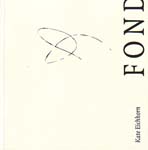 Reviewed by Aaron Tucker
Reviewed by Aaron Tucker
Fond
Kate Eichhorn
BookThug, 2008
80 pages, $20
The modern mind is no longer asked to remember. As Google swallows information, repackages and archives it, the need for memory shrinks; it becomes far more important to know where and how to find a fact than to retain that same fact. Therefore the act of reading becomes analogous to the search function in a web browser — type in what’s needed, consume and move on. In this way, the book is in danger of becoming a museum, a static, indexed object, complete and finite; the book as a clear and identifiable set of facts, a space to be entered and left, all without leaving a trace.
At the centre of Kate Eichhorn’s Fond is the question of how the modern person consumes and stores information. This is a book about archives and archiving, less a description and more a readerly call to arms. To this end, Fond creates a kinetic and amorphous text that is steeped in process. The poems move around the page, hiding in the corners, emerging hand-edited in the middle, jammed to the left or right. The reader cannot digest these poems in any consistent way; this constant shifting creates a landscape of reading that is inherently reflexive and unique. The reader must confront his/her own individual reading process — how do you read a poem set up like a database? How can you translate a slash or marginalized scribble? The movement from page to page highlights this process of reading and responding, of lingering, and is essential: this questioning generates an awareness of reading that is central to the text and begins to take the book beyond the static page.
In the same way, the constant scrawls and drawings that litter the text draw attention to the very construction of the text. The reader returns again and again to looping scrawls, to words scratched out or written over. Sometimes their meaning is set to an equation and prescribed: “= no possibility of desire without forgetfulness/skin without trace” or “= the shape of one reading.” Without one strict meaning the symbols allow multiple readings, forcing the reader again back to his/her process of interpretation; in contrast the authorial scribbles, by their constantly evolving presence, eventually de-centre the semantic meaning of the actual words — the reader begins to see the printed words as similar marks on a page, as loops or lines, as symbols separate from their meaning, more like sketches than letters. Without strict meaning attached to words and phrases, the archive’s purpose shifts, away from cross-indexing or dissecting for quick access and departure. The process of interpreting information instead turns away from the objective fact toward a more personal procedure.
Therefore the book concerns itself largely with its margins, the spaces at the edges of the text. If modern information is constant and searchable, then Fond argues that readers should be most concerned with the places that excess memory and information leaks into — the borders, the places around the archive and text. Every reader has picked up a used book and found the borders of the page scattered with notes, intimate and forever expansive — it is this reaction to a text that goes beyond the archive as strict information and asks for personal response. Fond edits itself in much the same way, with scribbles, erasure lines and hastily drawn arrows and boxes.
The reader is encouraged to “damn the spillage,” unravel “borrowed threads” and enter into the spaces outside the straight edges of text. These are the places of interaction, where “annotation/exacerbates/this weakness” and there is “no archive of repetition and archive.” So the spaces where the book can be the most flexible are at its margins, where the readers can scribble in the notes, respond to and add to the work. It is not, then, the information contained within the text, but the reaction to it, that is championed.
Fond surfaces with a reimaging of the archive as a body, the process of reading balanced between cerebral thrust and bodily awareness. The text insists that “where bodies appear mere surfaces there is still/skin” — readers are reminded that the surface of the page is its skin, its living (and frenetic) organic matter. The archive lives, is active and assertive when treated as such, is a corporeal entity. From this, the reader must reflect on his/her own body: suddenly thumbs hold pages and feel the rough grain of print and paper; the arms straighten for greater comfort; the eyes scan and the mouth crinkles in reaction. It is not enough to think about a text; the reader must also be bodily involved.
It is with this sleight of hand that Fond is most striking and beautiful. After reading this text, one may no longer see books as museums but rather as a series of unique readerly choices and reactions, grounded in subjectivity and the physicality of the individual body. Information, the archive, is alive and active.
Aaron Tucker contributes regular reviews to Broken Pencil and Matrix magazine in addition to editing the online poetry review site Agora (www.agorareview.ca). He lives, writes and teaches in Toronto.






